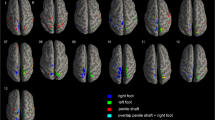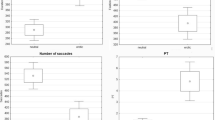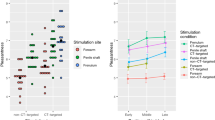Abstract
The aim of this study was to elucidate the brain processes preceding penile responses. Electroencephalographic (EEG) potentials and penile circumference were recorded simultaneously while male subjects were exposed to visual sexual stimuli (VSS). The trials were sorted by the penile response of the subjects (erection, maintenance or detumescence). The corresponding EEG recordings were then subjected to independent component analysis. We found that 200 ms after VSS onset brain potentials differ according to the genital response to follow. Whereas early posterior negativity (EPN) was predominantly related to erection and maintenance, P3-like activity was found to precede detumescence. EPN indicates a more ‘emotional’ processing state of the brain, whereas P3-like activity related to detumescence indicates a more ‘cognitive’ processing state. The latter is assumed to reflect activity of the locus coeruleus–norepinephrine system. Further research should evaluate the contribution of P3-related brain activity to psychogenic erectile dysfunction.
This is a preview of subscription content, access via your institution
Access options
Subscribe to this journal
Receive 8 print issues and online access
$259.00 per year
only $32.38 per issue
Buy this article
- Purchase on Springer Link
- Instant access to full article PDF
Prices may be subject to local taxes which are calculated during checkout




Similar content being viewed by others
References
Temel Y, Hafizi S, Tan S, Visser-Vandewalle V . Role of the brain in the control of erection. Asian J Androl 2006; 8: 259–264.
Giuliano F, Rampin O . Neural control of erection. Physiol Behav 2004; 83: 189–201.
Arnow BA, Desmond JE, Banner LL, Glover GH, Solomon A, Polan ML et al. Brain activation and sexual arousal in healthy, heterosexual males. Brain 2002; 125 (Part 5): 1014–1023.
Ferretti A, Caulo M, Del Gratta C, Di Matteo R, Merla A, Montorsi F et al. Dynamics of male sexual arousal: distinct components of brain activation revealed by fMRI. Neuroimage 2005; 26: 1086–1096.
Georgiadis JR, Holstege G . Human brain activation during sexual stimulation of the penis. J Comp Neurol 2005; 493: 33–38.
Holstege G, Georgiadis JR, Paans AM, Meiners LC, van der Graaf FH, Reinders AA . Brain activation during human male ejaculation. J Neurosci 2003; 23: 9185–9193.
Miyagawa Y, Tsujimura A, Fujita K, Matsuoka Y, Takahashi T, Takao T et al. Differential brain processing of audiovisual sexual stimuli in men: comparative positron emission tomography study of the initiation and maintenance of penile erection during sexual arousal. Neuroimage 2007; 36: 830–842.
Moulier V, Mouras H, Pelegrini-Issac M, Glutron D, Rouxel R, Grandjean B et al. Neuroanatomical correlates of penile erection evoked by photographic stimuli in human males. Neuroimage 2006; 33: 689–699.
Mouras H, Stoleru S, Moulier V, Pelegrini-Issac M, Rouxel R, Grandjean B et al. Activation of mirror–neuron system by erotic video clips predicts degree of induced erection: an fMRI study. Neuroimage 2008; 42: 1142–1150.
Park K, Seo JJ, Kang HK, Ryu SB, Kim HJ, Jeong GW . A new potential of blood oxygenation level dependent (BOLD) functional MRI for evaluating cerebral centers of penile erection. Int J Impot Res 2001; 13: 73–81.
Redoute J, Stoleru S, Gregoire MC, Costes N, Cinotti L, Lavenne F et al. Brain processing of visual sexual stimuli in human males. Hum Brain Mapp 2000; 11: 162–177.
Stoleru S, Gregoire MC, Gerard D, Decety J, Lafarge E, Cinotti L et al. Neuroanatomical correlates of visually evoked sexual arousal in human males. Arch Sex Behav 1999; 28: 1–21.
Stoleru S, Mouras H . Brain functional imaging studies of sexual desire and arousal in human males. In: Janssen E (eds) The Psychophysiology of Sex. Indiana University Press: Bloomington, 2007, pp 3–34.
LeDoux J . The Emotional Brain. Simon & Schuster: New York, 1996.
Öhman A, Flykt A, Lundqvist D . Unconscious emotion: evolutionary perspectives, psychophysiological data and neuropsychological mechanisms. In: Lane RD, Nadel L (eds) Cognitive Neuroscience of Emotion. Oxford University Press: Oxford, 2000, pp 296–327.
Spiering M, Everaerd W . The sexual unconscious. In: Janssen E (eds) The Psychophysiology of Sex. Indiana University Press: Bloomington, 2007, pp 166–184.
Junghöfer M, Bradley MM, Elbert TR, Lang PJ . Fleeting images: a new look at early emotion discrimination. Psychophysiology 2001; 38: 175–178.
Cuthbert BN, Schupp HT, Bradley MM, Birbaumer N, Lang PJ . Brain potentials in affective picture processing: covariation with autonomic arousal and affective report. Biol Psychol 2000; 52: 95–111.
Kornhuber HH, Deecke L . [Changes in the brain potential in voluntary movements and passive movements in man: readiness potential and reafferent potentials.]. Pflugers Arch Gesamte Physiol Menschen Tiere 1965; 284: 1–17.
Onton J, Westerfield M, Townsend J, Makeig S . Imaging human EEG dynamics using independent component analysis. Neurosci Biobehav Rev 2006; 30: 808–822.
Makeig S, Bell AJ, Jung TP, Sejnowski TJ . Independent component analysis of electroencephalographic data. Adv Neural Inf Process Syst 1996; 8: 145–151.
Ku Y, Ohara S, Wang L, Lenz FA, Hsiao SS, Bodner M et al. Prefrontal cortex and somatosensory cortex in tactile crossmodal association: an independent component analysis of ERP recordings. PLoS ONE 2007; 2: e771.
Makeig S, Delorme A, Westerfield M, Jung TP, Townsend J, Courchesne E et al. Electroencephalographic brain dynamics following manually responded visual targets. PLoS Biol 2004; 2: e176.
Mehta J, Jerger S, Jerger J, Martin J . Electrophysiological correlates of word comprehension: event-related potential (ERP) and independent component analysis (ICA). Int J Audiol 2009; 48: 1–11.
Ventouras E, Moatsos M, Papageorgiou C, Rabavilas A, Uzunoglu N . Independent component analysis applied to the P600 component of event-related potentials. Conf Proc IEEE Eng Med Biol Soc 2004; 1: 80–83.
Zeman PM, Till BC, Livingston NJ, Tanaka JW, Driessen PF . Independent component analysis and clustering improve signal-to-noise ratio for statistical analysis of event-related potentials. Clin Neurophysiol 2007; 118: 2591–2604.
Oldfield RC . The assessment and analysis of handedness: the Edinburgh inventory. Neuropsychologia 1971; 9: 97–113.
Franke G . Die Symptom-Checkliste von Derogatis. Deutsche Version. Beltz: Göttingen, Germany, 1996.
Kirk KM, Bailey JM, Dunne MP, Martin NG . Measurement models for sexual orientation in a community twin sample. Behav Genet 2000; 30: 345–356.
Zuckerman M . Physiological measures of sexual arousal in the human. Psychol Bull 1971; 75: 297–329.
Delorme A, Makeig S . EEGLAB: an open source toolbox for analysis of single-trial EEG dynamics including independent component analysis. J Neurosci Methods 2004; 134: 9–21.
Tsai AC, Liou M, Jung TP, Onton JA, Cheng PE, Huang CC et al. Mapping single-trial EEG records on the cortical surface through a spatiotemporal modality. Neuroimage 2006; 32: 195–207.
Moores KA, Clark CR, Hadfield JL, Brown GC, Taylor DJ, Fitzgibbon SP et al. Investigating the generators of the scalp recorded visuo-verbal P300 using cortically constrained source localization. Hum Brain Mapp 2003; 18: 53–77.
Schupp HT, Flaisch T, Stockburger J, Junghofer M . Emotion and attention: event-related brain potential studies. Prog Brain Res 2006; 156: 31–51.
Rockstroh B, Elbert T, Birbaumer N, Lutzenberger W . Slow Brain Potentials and Behavior 2nd edn Urban & Schwarzenberg: Baltimore, 1989.
Libet B . Unconscious cerebral initiative and the role of conscious will in voluntary action. Behav Brain Sci 1985; 8: 529–566.
Nieuwenhuis S, Aston-Jones G, Cohen JD . Decision making, the P3, and the locus coeruleus–norepinephrine system. Psychol Bull 2005; 131: 510–532.
Chang AY, Huang CM, Chan JY, Chan SH . Involvement of noradrenergic innervation from locus coeruleus to hippocampal formation in negative feedback regulation of penile erection in the rat. Hippocampus 2001; 11: 783–792.
Giuliano F, Rampin O . Central noradrenergic control of penile erection. Int J Impot Res 2000; 12 (S1): S13–S19.
Marson L, Platt KB, McKenna KE . Central nervous system innervation of the penis as revealed by the transneuronal transport of pseudorabies virus. Neuroscience 1993; 55: 263–280.
Vardi Y, Volos M, Sprecher E, Granovsky Y, Gruenwald I, Yarnitsky D . A P300 event related potential technique for assessment of sexually oriented interest. J Urol 2006; 176 (6 Part 1): 2736–2740.
Author information
Authors and Affiliations
Corresponding author
Rights and permissions
About this article
Cite this article
Ponseti, J., Kropp, P. & Bosinski, H. Brain potentials related to the human penile erection. Int J Impot Res 21, 292–300 (2009). https://doi.org/10.1038/ijir.2009.31
Received:
Revised:
Accepted:
Published:
Issue Date:
DOI: https://doi.org/10.1038/ijir.2009.31
Keywords
This article is cited by
-
Brain potentials related to corpus cavernosum electromyography
International Journal of Impotence Research (2010)



